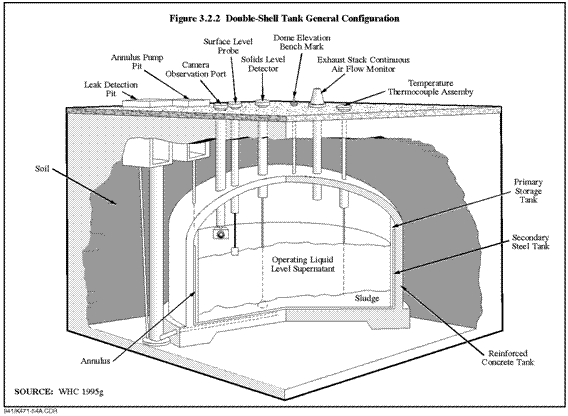The Hanford nuclear facility contains fifty three million gallons of high-level radioactive and chemical waste. These wastes were generated when corrosive chemicals were used to dissolve spent fuel rods to retrieve plutonium. Steel tanks in concrete pits are used to hold the waste.
One hundred and forty nine single-shell tanks were built between 1943 and 1964. The tanks were designed to last 20 years and were never intended as a permanent storage system. The waste has been eating away at the lining of the tanks since they were filled. One third of the tanks have been eaten thought completely in places and they are leaking the waste into the environment. Twenty eight double-shell tanks were built between 1977 and 1986 to accept waste from the deteriorating single-shelled tank.
The operators at the site monitor the conditions in the tanks and move waste from the older single-shell and double-shell tanks to twenty eight newer double-shelled tanks when required but space in the new tanks is limited. Robotic systems have been developed to handle the extremely dangerous and toxic waste but they are not always employed and workers are endangered when required to deal with the waste.
The area between the inner and outer shells of the double-shelled tanks is called the “annulus.” Annulus is Latin for little ring. It is a term generally applied to any gap between concentric pipes.
Recently a three foot long solid lump was discovered between the inner and outer shells of one of the double-shelled tanks designated AY-102 built 42 years ago. The tank contains 857,000 gallons recovered from one of the older single-shelled tanks that was considered unsafe. There is no
The lump has been sampled and it contains radioactive materials indicating that it is radioactive waste. There is some confusion over where the lump came from. One idea is that it leaked through the inner shell of the tank. The other possibility is that it came from leakage from one of the older tanks that made its way into the annulus of the newer tank. There is no evidence that the outer-shell of the tank has been breached and there does not appear to be any danger of contamination of soil or ground water at this time.
Further research is being carried out to determine exactly where the lump came from. If it turns out that the material in the lump did leak through the inner shell of the newer tank, then there is a serious problem with the project to use the newer tanks to hold the waste from the older tanks that are leaking. The new design was supposed to safely hold the waste while a permanent storage solution was perfected. If the newer tanks are also starting to leak, then the current leakage problems at Hanford do not have a solution and new efforts will have to be started to protect the environment in the Hanford area.
Double-shell tank diagram from globalsecurity.org
